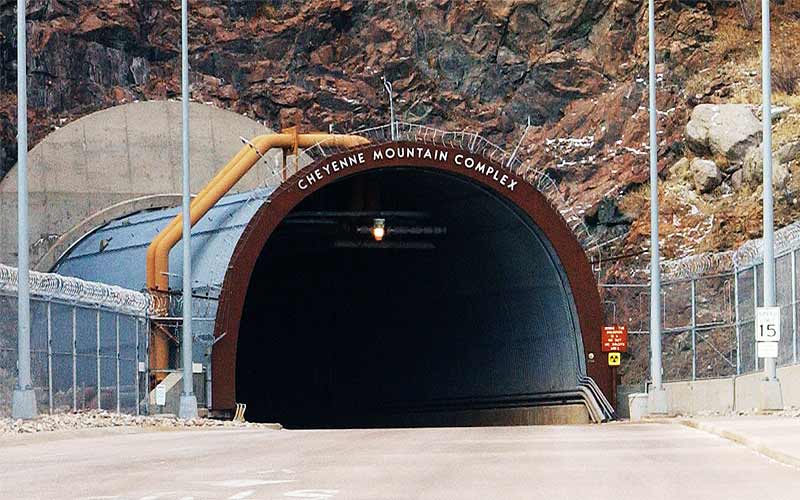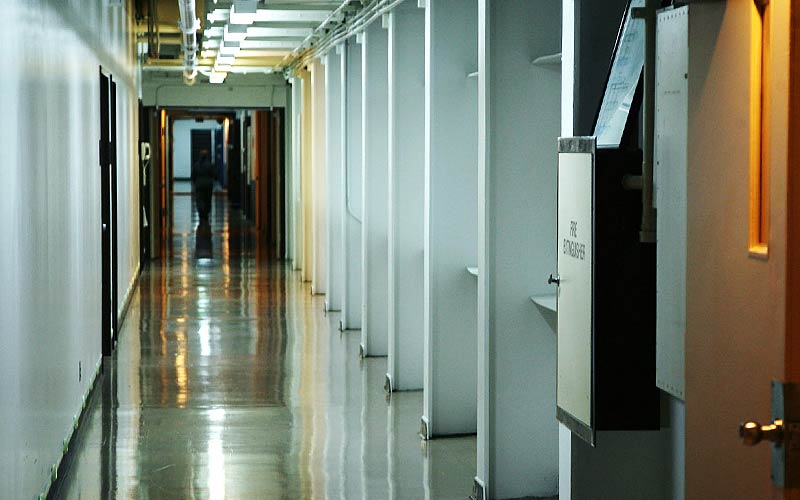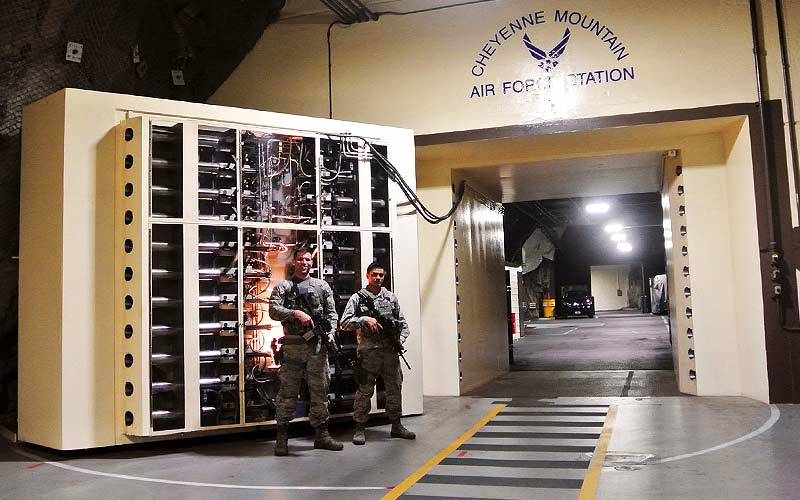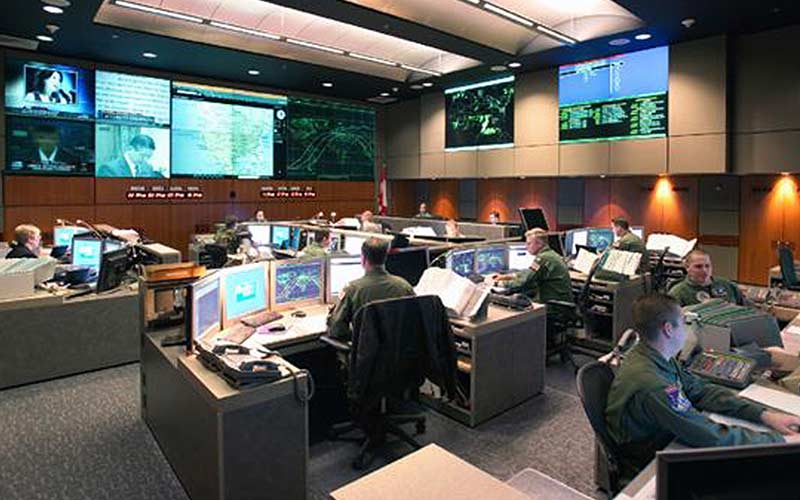The World's Most Secure Buildings: Cheyenne Mountain Complex
February 4, 2021
Cheyenne Mountain Complex is a protected, closed-to-the-public underground facility situated inside Cheyenne Mountain in the southwest corner of Colorado Springs, Colorado.
This unique concept of a tough command and control center was actualized as a shield against long-range Soviet bombers at the peak of the Cold War in the late 1950s. Excavated by the Army Corps of Engineers, the complex became fully functional as the North American Aerospace Defense Command (NORAD) Combat Operations Center on
February 6, 1967.
According to the Department of Defense (DOD), the complex is held and run by Air Force Space Command, with NORAD and United States Northern Command (USNORTHCOM) occupying approximately 30% of the floor space and around 5% of day-to-day operations.

Today, the facility acts as NORAD and USNORTHCOM's Alternate Command Center and as a staff training site.
What makes Cheyenne Mountain Complex one of the world’s most secure buildings?
Cheyenne Mountain Complex Stats
- Cheyenne Mountain Complex is located under 2,000 feet (600 meters) of granite
- The facility has six (6) tunnels and each tunnel is three (3)-stories tall
- The complex is secured against seismic activity and nuclear explosions and is also strengthened against electromagnetic pulse (EMP) attacks
- Major Hollywood productions, including “War Games” and “Stargate”, have visualized parts of Cheyenne Mountain
- The two main blast doors leading into the complex take around 45 seconds to shut
- The blast doors are 3.5 feet (5.63 kilometers) thick and weigh over 20 tons
- The doors are only closed in times of emergency; they have only been closed once during 9/11
Facilities in Cheyenne Mountain Complex
Main Chambers
The complex was carved out below 2,000 feet of granite on two hectares. There are 15 three-story buildings resting on a system of huge springs that secure them from moving, such as during earthquakes or blasts. The operational impact of shifting is restricted by flexible pipe connectors.
Over 1,000 springs are used to keep the buildings from moving more than an inch. Cheyenne Mountain Complex is the only high-altitude facility that is certified by the DOD to withstand EMPs. It houses several makeshift beds for the majority of employees, including suites for eminent officers within the complex. Other facilities include a department store, canteen, and health centers within and outside the complex.
Blast Doors
The complex can withstand a 30-megaton atomic blast in a range as close as 1.24 miles (2 kilometers). It also has a series of 25-ton blast doors. The civil engineering division is protected behind an additional blast door. These doors are constructed in a way that they can be easily unlocked when required.
In case an atomic explosion hits the complex, the doors can tolerate an explosion wave. The complex also has a system of explosion stopcocks with unique filters to seize aerial biochemical, radiological, and atomic contaminants.

Outdoors
Outside the complex, there are parking spaces, a fire station, and leisure amenities, including
Cheyenne Mountain State Park, picnic areas, a racquetball court, softball field, sand volleyball court, and basketball court. A military gateway restricts NORAD Road use from the State Highway 115 interchange.
Support Area
The facility has its own power plant, heating and cooling system, and water supply. The
21st Mission Support Group guarantees maximum reliability of its electricity, water, air conditioning, power, and other support systems.
The mountain springs produce more water than the base requires. A 1.5 million-gallon tank guarantees that even in the event of a fire, there is sufficient water to fulfill the facility's requirements. A water tank of 4.5 million gallons is used as a heat sink. There is also a huge tank for diesel fuel and a massive battery bank with backup power generators.

Operation Centers in Cheyenne Mountain Complex
The Cheyenne Mountain Complex has several centers that carry out missile, atmospheric, and space warning activities. These operation centers include:
Air Operations Center (AOC)
AOC upholds continuous scrutiny of the airspace in North America to avert overflight by hostile airliners. The center tracks more than 2.5 million airplanes annually. It gathers and combines investigation data on alleged drug-laden airplanes arriving or functioning within the North American region and delivers this data to anti-narcotics organizations.
Missile Warning Center (MWC)
This center identifies missile launches worldwide and decides whether they are a risk to the North American region.
Space Control Center (SCC)
SCC detects, recognizes, and tracks all synthetic items in space. It presently tracks more than 8,000 items including freights, rocket bodies, and wreckage. Identifying the location and position of these items supports numerous mission areas, including collision prevention for the space shuttle team.
NORAD/USSPACECOM Combined Command Center (CCC)
CCC acts as the hub for all activity within the operation centers. It provides coordination and direction to the mission operation centers. It also offers warning and evaluation of attack on the North American region or its allies to the National Command Authorities (NCA), USSTRATCOM, and others.

Combined Intelligence Watch Center (CWIC)
CWIC acts as the warning center for global intimidations from space, missile, and strategic air activity, along with geopolitical turbulence that could disturb North America and U.S. forces/interests overseas. Its employees collect intelligence to support all Cheyenne Mountain Complex operation centers in investigating events to assist decision-makers at NORAD and USSPACECOM.
National Warning Facility (NWF)
NWF is the U.S. civil defense warning center situated in the Aerospace Defense Command Post to provide Federal Emergency Management Agency (FEMA) with access to warning data. In the event of an attack, the center would trigger the alarm of the National Warning System.
Space and Warning Systems Center (SWSC)
SWSC manages the upkeep and development of mission-critical software, fulfilling operational requirements for NORAD and USSPACECOM. It presently preserves more than 12 million lines of code on 34 distinct operational systems written in 27 different languages.
Weather Support Center (SOLAR)
This center is situated in building 1470 on Peterson Air Force Base (AFB). It monitors local and global weather patterns and also reports to the Command Center.
Cheyenne Mountain Upgrade (CMU) Program
The CMU program advances ballistic missile, air, space, and command center elements within the facility. It also modernizes and offers new capability to survivable communications and warning elements at the National Military Command Center (NMCC), U.S. Strategic Command, and other locations. It provides a robust Alternate Missile Warning Center standby to the complex at Offutt Air Force Base, Nebraska.
CMU supports the Joint Chiefs of Staff's military concept of full-dimensional defense to the warfighter, improving the capability of the country’s civilian and military leadership to quickly and precisely correlate Integrated Tactical Warning/Attack Assessment (ITW/AA) information and prepare and implement the suitable response.
From a functional perspective, the CMU program is a network of systems, comprised of the following six:
- Survivable Communications Integration System (SCIS)
- Command Center Processing and Display System Replacement (CCPDS-R)
- Alternate Missile Warning Center (A/MWC)
- Space Defense Operations Center 4 (SPADOC 4)
- Granite Sentry
- Communications System Segment Replacement (CSSR)
What Makes Cheyenne Mountain Complex One of the World’s Most Secure Buildings?
Even though NORAD called off its “nuclear watch” in 1992 after the disintegration of the Soviet Union, the complex is still packed with electronics and personnel scrutiny facilities for terrorist assaults and cyber-attacks along with artillery.
The focus and amenities of NORAD have both grown to tackle the threats of the modern era. Comprising a large number of tunnels and 15 buildings mounted on shock-absorbing springs, the complex can withstand and remain operational even through a 30-megaton nuclear explosion. It is sheltered by a series of 25-ton steel blast doors.
Much of its safety comes from the facility’s very underground-ness. Given that drillers had to dig more than 693,000 tons of granite to create the complex, its entrance itself is remarkable. The fact that it sits 2,000 feet under Cheyenne Mountain keeps the complex secure against aerial attacks. The facility is further protected by two huge blast doors made of concrete and steel, each 3.5 feet thick and weighing 23 tons.
At the core is a network of six (6) tunnels up to 40 feet wide and three (3) stories tall. These tunnels hold well-connected buildings made of steel plates, positioned on huge coil springs to absorb the tremor of a nuclear explosion or seismic activity. The granite and steel also guard electronics against damaging pulses of electromagnetic energy that nuclear blasts yield.
If an EMP hits near the mountain, it could easily knock out everything in the surrounding area. However, inside the facility, supercomputers and the lines feeding into them remain secure. The rock covering weakens the electromagnetic waves along with the metal buildings, which act like huge Faraday enclosures.
Want to Secure Your Building?
Identiv's physical access control system (PACS) and video intelligence solutions provide the highest security at the lowest cost. Robust, feature-rich systems, hardware, and software verify frictionless access managed from anywhere.
Learn more about our PACS solutions by contacting +1 888.809.8888 or
sales@identiv.com.
